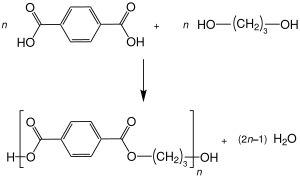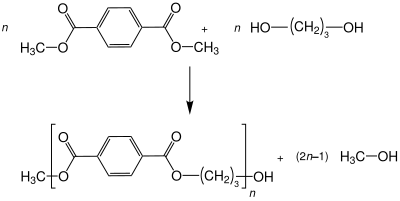Polytrimethylene terephthalate
Polytrimethylene terephthalate (PTT), is a polyester synthesized and patented in 1941.[1][2] It is produced by a method called condensation polymerization or transesterification. The two monomer units used in producing this polymer are: 1,3-propanediol and terephthalic acid or dimethyl terephthalate. Similar to polyethylene terephthalate, the PTT is used to make carpet fibers.
 | |
| Names | |
|---|---|
| Other names
Poly(trimethylene terephthalate); Poly(oxy-1,3-propanediyloxycarbonyl-1,4-phenylenecarbonyl) | |
| Identifiers | |
| ChemSpider |
|
CompTox Dashboard (EPA) |
|
| Properties | |
| (C11H10O4)n | |
Except where otherwise noted, data are given for materials in their standard state (at 25 °C [77 °F], 100 kPa). | |
| Infobox references | |
PTT's value as a commercial polymer has improved due to more economical and efficient methods to produce 1,3-propanediol in the 1980s by Degussa, via acrolein, and Shell via the hydroformylation of ethylene oxide.[3] DuPont has successfully commercialized the production of this polymer via 1,3-propanediol obtained by fermentation. These developments may allow PTT to effectively compete against PBT and PET, two polyesters that have been far more successful than PTT to date.
Production
Similar to the ubiquitous poly(ethylene terephthalate), this polymer is prepared by the esterification of 1,3-propanediol (HO(CH2)3OH) with terephthalic acid (C6H4(COOH)2), or by transesterification of dimethyl terephthalate:[3]
| Reaction scheme of PTT-synthesis … | |
|---|---|
 | … by esterification. |
 | … by transesterification. |
Applications
On Friday, March 20, 2009, the Federal Trade Commission approved a subclass to traditional polyester called triexta.[4] The PTT fiber that is currently used in Mohawk's SmartStrand carpet as well as Dupont uses with their brand Sorona, can now be labeled triexta.
The FTC last approved an extension for residential carpet in 1959. The process of getting the FTC to approve the triexta polyester subclass was a joint effort between Mohawk Industries and DuPont. The process started back in 2006 and took nearly 3 years to be approved.
References
- John Rex Whinfield and James Tennant Dickson (1941) "Improvements Relating to the Manufacture of Highly Polymeric Substances", UK Patent 578,079; "Polymeric Linear Terephthalic Esters", U.S. Patent 2,465,319 Publication date: March 22, 1949; Filing date: September 24, 1945; Priority date: July 29, 1941
- Max M. Houck; et al. (July 2001). "Poly(Trimethylene Terephthalate): A "New" Type of Polyester Fiber". Forensic Science Communications. 3 (3). Archived from the original on November 11, 2005.
- Helmut Sattler; Michael Schweizer. "Fibers, 5. Polyester Fibers". Ullmann's Encyclopedia of Industrial Chemistry. Weinheim: Wiley-VCH. doi:10.1002/14356007.o10_o01.
- "FTC Approves Federal Register Notice Establishing New Fiber Name and Definition" (Press release). Federal Trade Commission. 2009-03-20.